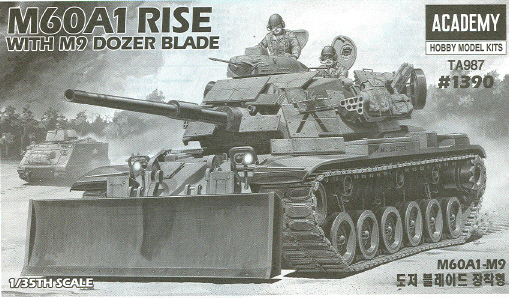Academy's 1/35-scale Optional Parts
Series No.1374: U.S. M9 Dozer Blade Set
by Cookie Sewell

Contains: 57 parts in olive drab styrene.
Price: US $2.49
Advantages: well-done accessory for any M60 series tank; clean, neat
moldings include the new headlights required by this modification.
Disadvantages: no information or parts provided for hooking the mechanism
up to the tank (operating mechanisms, not mounting hardware).
Rating: Highly recommended for all US armor fans, M60 fans, and "picks
and shovels" fans.
Engineer equipment is something that doesn't get the coverage it probably
deserves in the modeling world. Anyone who has ever worked around combat
arms units knows that without engineer support most units would have a
hard time of getting around – either crossing water obstacles, negotiating
narrow roads (if there are any at all) or clearing the debris of war that
often clogs up the way ahead.
In World War II, after experimenting with armored bulldozers, the US
Army found the easiest solution to its problems was to simply mount a
bulldozer blade on a standard M4 Medium Tank and use it where needed.
This had several advantages. One, the bulldozer operator was no longer
at the mercy of the enemy and was protected from any snipers or infantry
in the vicinity. Two, the tank had sufficient gearing and power to ensure
most obstacles could be cleared away or filled in; firing scrapes for
tanks in the defense or artillery pits could also be dug in short order.
And three, if the bulldozer found the enemy, a big gun gave the bulldozer
the chance to carry out the modern mantra: "Fight crime – shoot
back!"
The first blade assembly, the M1, was designed in mid 1943 for use on
the M4 series tanks fitted with the vertical volute (VVSS) suspension
system. Later, a slightly broader one, the M1A1, was created for use with
either the expanded VVSS suspension ("E9") or the wider horizontal
volute (HVSS or "E8") suspension. While few tanks were dedicated
as engineer assets, many units used them as normal route clearing vehicles.
A total of 1.957 M1 kits were made during WWII.
In Korea, the USMC fitted the M1A1 blade or the more compact M2 blade
to M4A3 (105) howitzer tanks and used them as multipurpose machines on
the battlefield.
Others followed after the war. The M3 blade was designed for the M47,
the M8 series for the M48 family of tanks, and the M9 for the M60 series
tanks. The M9 was identical to the M8 series except for the mounting fittings
that connected the blade and its associated control hardware to the front
of the tank. The M8s differed in where the hydraulic lines for operating
the blades attached to the hull; early models attached to the top right
rear of the tank, and later models ran their lines down an armored cover
to a connector at the left bottom rear of the hull. The M9 used the same
system as the late M8 series blades.
Academy released a kit of what it originally dubbed an "M728 Combat
Engineer Vehicle" but later redesignated as an M60A1 RISE with M9
Dozer Blade. That was correct, and now they have released the blade assembly
separately for use on any M60 kit. The parts are very neatly done, with
all ejection pin markings either concealed or "standing proud"
to allow for easy removal. If the modeler is careful, the finished product
will even operate correctly as its prototype.
The kit also includes the "stalk" mounted headlight assemblies
necessary to "see" over the top of the blade in travel position.
While the parts included are very well done and accurate, there are some
omissions which are sure to bug modelers. One is the travel lock assembly,
which is a glacis-width bar that carries safety hooks that the driver
can engage to ensure the blade remains in its travel position while moving.
The other is the hydraulic takeoff from the rear of the hull for operating
the blade, and all of those parts – armored fitting box, armored
cover run, and any flexible lines to hook up to the blade assembly –
are missing. Also missing is the control cable that goes into the driver's
compartment via one of his viewers (in order to operate the system from
his position.)
Alas, references are scarce on the specifics so anyone who wants to super-detail
the blade assembly will have to do some running around. But what the modeler
gets is better than most resin kits, and one cannot argue about the price.
Cookie Sewell
|